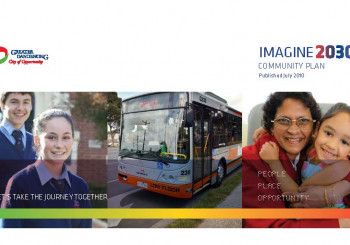
The 18 month Imagine 2030 Project aimed to find out what people have in common, what opinions and aspirations they share about the future, and what topics people might work on together.
It laid the groundwork for integrating Council's own four-year strategic Council Plan 2009-13 with the Community Plan, and the review processes thereafter. It has also provided a foundation for the current Council Plan 2017-21.
In 2017 the Community Plan - Imagine 2030 was reviewed as part of the process to develop a new Council Plan. A number of consultation activities were held to determine the key priorities of our community and key stakeholders and help Council to set its direction for the next four years. The results of the consultation aligned with the priorities expressed in 2009 with the addition of tourism and attracting visitors to our city. An updated summary of Imagine 2030 has been developed to include this new priority.
A plan by the community
In 2009, over 3000 comments were recorded from around 1700 participants and respondents during research, consultation, focus groups, workshops, discussion circles, and surveys reaching most sectors in the community.
A focus group format was developed for consultation with young people and cultures from non-English speaking backgrounds. Representatives of these sectors were recruited and trained in facilitating focus groups, and the Imagine 2030 Model, then sent off to recruit their groups and notetakers, and asked to report back focus group discussion notes. Migrant groups conducted discussions in their languages of origin, and facilitators returned reports in English.
The final stages of the project included participant feedback on a discussion paper, which has been updated and published as the evidential part of the community plan.
A plan for the community
This community plan is a must for anyone working with the Greater Dandenong community, especially community and government agencies, those applying for Council funding, and anyone who wants to help make this the best place with the best people.
Sectors for analysis
The project was designed to identify and compare the opinions of some prime sectors, specifically: residents at large; young people; CALD (Culturally and linguistically diverse) communities; business and manufacturing.
Sectors for targeting
At the next level down, research and consultation pathways were designed for each of the above, including attention to:
- community organisations receiving council community grants, or on council's correspondence lists
- community reference panel, and key Councillor contacts
- retail associations, and industry and manufacturing representatives
- Council staff (a large proportion are residents too)
- Councillors and Council management
